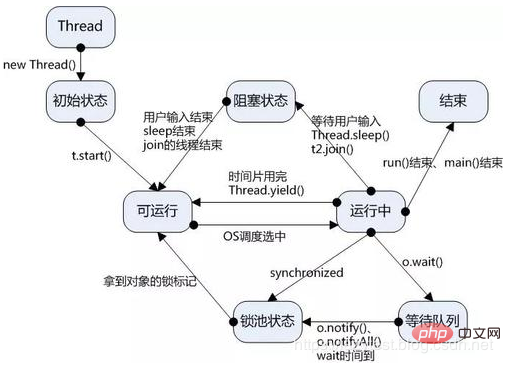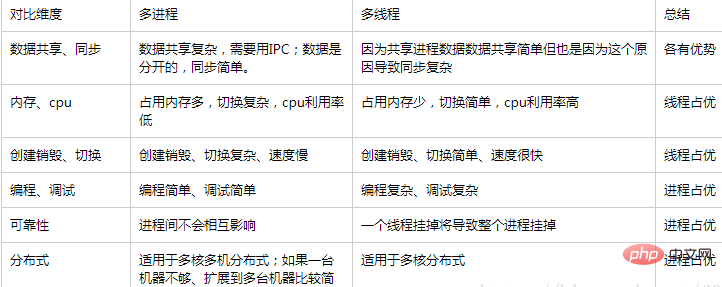Collection of classic Java interview questions (4)
Jul 09, 2020 pm 04:28 PM
1. Application scenarios of reflection mechanism
(Related tutorial recommendations: java interview questions)
Reverse code, such as decompilation
Framework combined with annotations such as Retrofit
Simple reflection mechanism Application frameworks such as EventBus 2.x
Dynamically generated class frameworks such as Gson
2. What is multi-threading?
Multi-threading refers to the technology that realizes the concurrent execution of multiple threads from software or hardware. In a program, these independently running program fragments are called "threads", and the concept of programming using them is called "multi-threading".
Computers with multi-threading capabilities can execute more than one thread at the same time due to hardware support, thus improving overall processing performance.

#The main thread is the first thread generated in the creation process, which is the thread corresponding to the main function.
(Recommended learning: java introductory program)
3. Tell me about the benefits of multi-threading?
1. Advantages of multi-threading
The cost of creating a new thread is much smaller than creating a new process
Compared with switching between processes, switching between threads requires the operating system to do very little work
Threads occupy much fewer resources than processes
Can make full use of the parallel number of multi-processors
After waiting for the slow IO operation to end, the program can perform other computing tasks
Computing (CPU)-intensive applications, in order to run on multi-processor systems, the calculation is broken down into multiple threads to implement
IO-intensive applications , in order to improve performance, IO operations are overlapped, and threads can wait for different IO operations.
2. Disadvantages of multi-threading
Performance loss (a computing-intensive thread is rarely blocked by external events and cannot communicate with other Threads share the same processor. When the number of computationally intensive threads is more than the available processors, there may be a large performance loss. The performance loss here refers to the additional synchronization and scheduling overhead. Two available Resources remain unchanged.)
The robustness is reduced (there is a lack of protection between threads. In a multi-threaded program, due to the slight difference in time allocation or the sharing of some incorrect The possible impact of adverse effects on variables that should be shared is very large.)
Lack of access control (because the process is the basic granularity of access control, calling certain OS in a thread Functions will affect the entire process.)
Increased programming difficulty (writing and debugging a multi-threaded program is much more difficult than a single-threaded program.)
4. What is the difference between threads and processes?
1. Scheduling
The process is a basic unit for the operating system to allocate resources. Threads are the basic unit of CPU scheduling.
2. Concurrency
After the introduction of threads, not only processes can be executed concurrently, but multiple threads in a process can also be executed concurrently, even allowing one All processes in the process execute concurrently.
Similarly, threads in different processes can also be executed concurrently. This enables the OS to have better concurrency, improving resource utilization and system throughput.
3. Owning resources
A process can own resources and is the basic unit of system resource ownership. The thread itself does not own system resources, only some resources that can ensure independent operation. This resource is private to each thread.
For example, thread ID, a set of registers, stack, errno, signal mask word (there is only one pending signal in a process, but any thread can handle this signal), scheduling priority.
4. Independence
The independence of threads in the same process is much lower than that in different processes.
5. System overhead
The cost of thread switching is lower than the cost of process switching.
6.Support multi-processor system
For traditional processes , that is, a single-threaded process, no matter how many processors there are, the process can only run on the same processor, but for a multi-threaded process, multiple threads in a process can be assigned to multiple processors, so that Its concurrent execution speeds up the completion of the process.
(Video tutorial recommendation: java video tutorial)
5. Application scenarios of processes and threads

Need to frequently create and destroy priority threads.
Prioritize threads that require large amounts of calculations.
Threads are used for strong correlations, and processes are used for weak correlations.
It may be extended to use processes for multi-machine distribution and threads for multi-core distribution.
The above is the detailed content of Collection of classic Java interview questions (4). For more information, please follow other related articles on the PHP Chinese website!

Hot AI Tools

Undress AI Tool
Undress images for free

Undresser.AI Undress
AI-powered app for creating realistic nude photos

AI Clothes Remover
Online AI tool for removing clothes from photos.

Clothoff.io
AI clothes remover

Video Face Swap
Swap faces in any video effortlessly with our completely free AI face swap tool!

Hot Article

Hot Tools

Notepad++7.3.1
Easy-to-use and free code editor

SublimeText3 Chinese version
Chinese version, very easy to use

Zend Studio 13.0.1
Powerful PHP integrated development environment

Dreamweaver CS6
Visual web development tools

SublimeText3 Mac version
God-level code editing software (SublimeText3)

Hot Topics
 How to iterate over a Map in Java?
Jul 13, 2025 am 02:54 AM
How to iterate over a Map in Java?
Jul 13, 2025 am 02:54 AM
There are three common methods to traverse Map in Java: 1. Use entrySet to obtain keys and values at the same time, which is suitable for most scenarios; 2. Use keySet or values to traverse keys or values respectively; 3. Use Java8's forEach to simplify the code structure. entrySet returns a Set set containing all key-value pairs, and each loop gets the Map.Entry object, suitable for frequent access to keys and values; if only keys or values are required, you can call keySet() or values() respectively, or you can get the value through map.get(key) when traversing the keys; Java 8 can use forEach((key,value)->
 Comparable vs Comparator in Java
Jul 13, 2025 am 02:31 AM
Comparable vs Comparator in Java
Jul 13, 2025 am 02:31 AM
In Java, Comparable is used to define default sorting rules internally, and Comparator is used to define multiple sorting logic externally. 1.Comparable is an interface implemented by the class itself. It defines the natural order by rewriting the compareTo() method. It is suitable for classes with fixed and most commonly used sorting methods, such as String or Integer. 2. Comparator is an externally defined functional interface, implemented through the compare() method, suitable for situations where multiple sorting methods are required for the same class, the class source code cannot be modified, or the sorting logic is often changed. The difference between the two is that Comparable can only define a sorting logic and needs to modify the class itself, while Compar
 How to handle character encoding issues in Java?
Jul 13, 2025 am 02:46 AM
How to handle character encoding issues in Java?
Jul 13, 2025 am 02:46 AM
To deal with character encoding problems in Java, the key is to clearly specify the encoding used at each step. 1. Always specify encoding when reading and writing text, use InputStreamReader and OutputStreamWriter and pass in an explicit character set to avoid relying on system default encoding. 2. Make sure both ends are consistent when processing strings on the network boundary, set the correct Content-Type header and explicitly specify the encoding with the library. 3. Use String.getBytes() and newString(byte[]) with caution, and always manually specify StandardCharsets.UTF_8 to avoid data corruption caused by platform differences. In short, by
 JavaScript Data Types: Primitive vs Reference
Jul 13, 2025 am 02:43 AM
JavaScript Data Types: Primitive vs Reference
Jul 13, 2025 am 02:43 AM
JavaScript data types are divided into primitive types and reference types. Primitive types include string, number, boolean, null, undefined, and symbol. The values are immutable and copies are copied when assigning values, so they do not affect each other; reference types such as objects, arrays and functions store memory addresses, and variables pointing to the same object will affect each other. Typeof and instanceof can be used to determine types, but pay attention to the historical issues of typeofnull. Understanding these two types of differences can help write more stable and reliable code.
 What is the 'static' keyword in Java?
Jul 13, 2025 am 02:51 AM
What is the 'static' keyword in Java?
Jul 13, 2025 am 02:51 AM
InJava,thestatickeywordmeansamemberbelongstotheclassitself,nottoinstances.Staticvariablesaresharedacrossallinstancesandaccessedwithoutobjectcreation,usefulforglobaltrackingorconstants.Staticmethodsoperateattheclasslevel,cannotaccessnon-staticmembers,
 Using std::chrono in C
Jul 15, 2025 am 01:30 AM
Using std::chrono in C
Jul 15, 2025 am 01:30 AM
std::chrono is used in C to process time, including obtaining the current time, measuring execution time, operation time point and duration, and formatting analysis time. 1. Use std::chrono::system_clock::now() to obtain the current time, which can be converted into a readable string, but the system clock may not be monotonous; 2. Use std::chrono::steady_clock to measure the execution time to ensure monotony, and convert it into milliseconds, seconds and other units through duration_cast; 3. Time point (time_point) and duration (duration) can be interoperable, but attention should be paid to unit compatibility and clock epoch (epoch)
 How does a HashMap work internally in Java?
Jul 15, 2025 am 03:10 AM
How does a HashMap work internally in Java?
Jul 15, 2025 am 03:10 AM
HashMap implements key-value pair storage through hash tables in Java, and its core lies in quickly positioning data locations. 1. First use the hashCode() method of the key to generate a hash value and convert it into an array index through bit operations; 2. Different objects may generate the same hash value, resulting in conflicts. At this time, the node is mounted in the form of a linked list. After JDK8, the linked list is too long (default length 8) and it will be converted to a red and black tree to improve efficiency; 3. When using a custom class as a key, the equals() and hashCode() methods must be rewritten; 4. HashMap dynamically expands capacity. When the number of elements exceeds the capacity and multiplies by the load factor (default 0.75), expand and rehash; 5. HashMap is not thread-safe, and Concu should be used in multithreaded
 What is a ReentrantLock in Java?
Jul 13, 2025 am 02:14 AM
What is a ReentrantLock in Java?
Jul 13, 2025 am 02:14 AM
ReentrantLock provides more flexible thread control in Java than synchronized. 1. It supports non-blocking acquisition locks (tryLock()), lock acquisition with timeout (tryLock(longtimeout, TimeUnitunit)) and interruptible wait locks; 2. Allows fair locks to avoid thread hunger; 3. Supports multiple condition variables to achieve a more refined wait/notification mechanism; 4. Need to manually release the lock, unlock() must be called in finally blocks to avoid resource leakage; 5. It is suitable for scenarios that require advanced synchronization control, such as custom synchronization tools or complex concurrent structures, but synchro is still recommended for simple mutual exclusion requirements.






